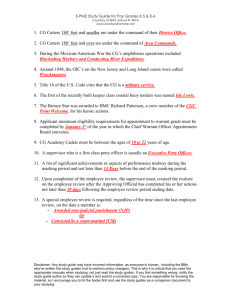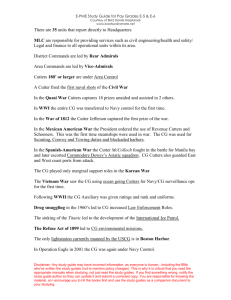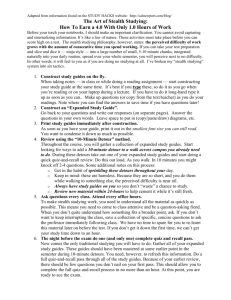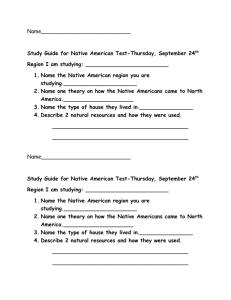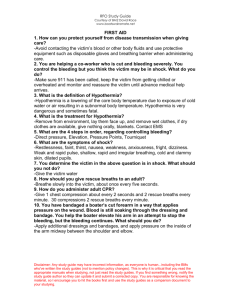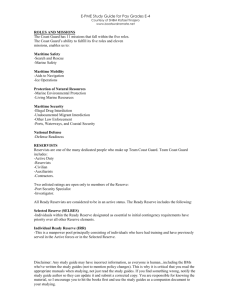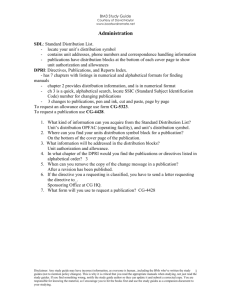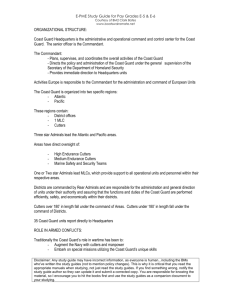E6 EPME TEST STUDY GUIDE
advertisement
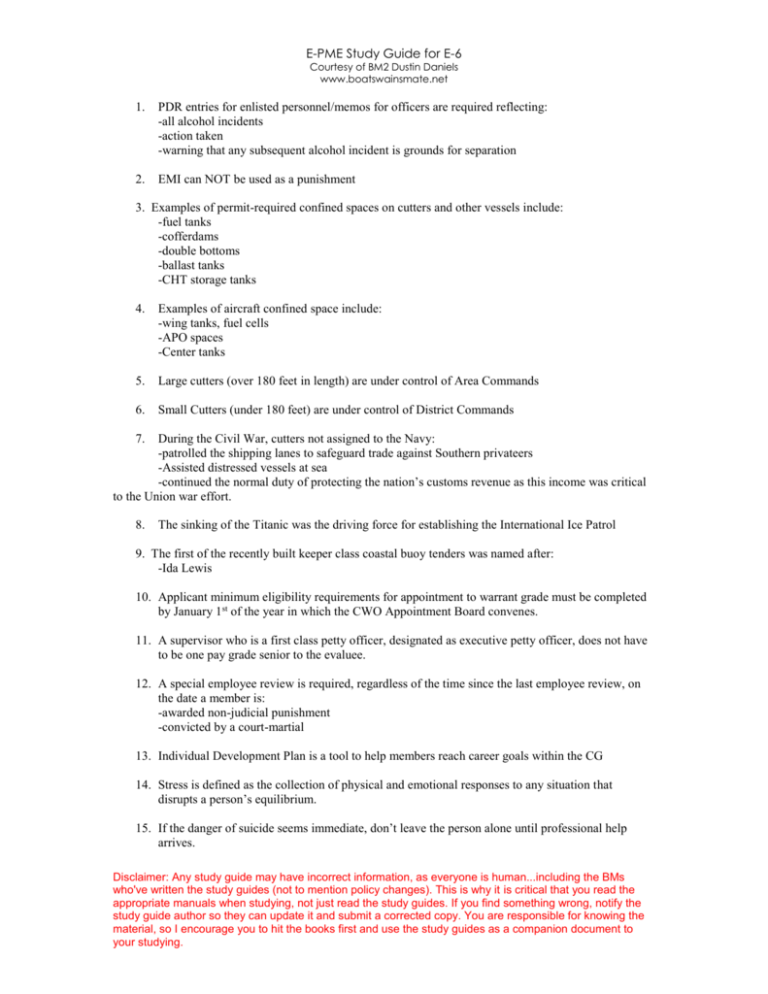
E-PME Study Guide for E-6 Courtesy of BM2 Dustin Daniels www.boatswainsmate.net 1. PDR entries for enlisted personnel/memos for officers are required reflecting: -all alcohol incidents -action taken -warning that any subsequent alcohol incident is grounds for separation 2. EMI can NOT be used as a punishment 3. Examples of permit-required confined spaces on cutters and other vessels include: -fuel tanks -cofferdams -double bottoms -ballast tanks -CHT storage tanks 4. Examples of aircraft confined space include: -wing tanks, fuel cells -APO spaces -Center tanks 5. Large cutters (over 180 feet in length) are under control of Area Commands 6. Small Cutters (under 180 feet) are under control of District Commands 7. During the Civil War, cutters not assigned to the Navy: -patrolled the shipping lanes to safeguard trade against Southern privateers -Assisted distressed vessels at sea -continued the normal duty of protecting the nation’s customs revenue as this income was critical to the Union war effort. 8. The sinking of the Titanic was the driving force for establishing the International Ice Patrol 9. The first of the recently built keeper class coastal buoy tenders was named after: -Ida Lewis 10. Applicant minimum eligibility requirements for appointment to warrant grade must be completed by January 1st of the year in which the CWO Appointment Board convenes. 11. A supervisor who is a first class petty officer, designated as executive petty officer, does not have to be one pay grade senior to the evaluee. 12. A special employee review is required, regardless of the time since the last employee review, on the date a member is: -awarded non-judicial punishment -convicted by a court-martial 13. Individual Development Plan is a tool to help members reach career goals within the CG 14. Stress is defined as the collection of physical and emotional responses to any situation that disrupts a person’s equilibrium. 15. If the danger of suicide seems immediate, don’t leave the person alone until professional help arrives. Disclaimer: Any study guide may have incorrect information, as everyone is human...including the BMs who've written the study guides (not to mention policy changes). This is why it is critical that you read the appropriate manuals when studying, not just read the study guides. If you find something wrong, notify the study guide author so they can update it and submit a corrected copy. You are responsible for knowing the material, so I encourage you to hit the books first and use the study guides as a companion document to your studying. E-PME Study Guide for E-6 Courtesy of BM2 Dustin Daniels www.boatswainsmate.net 16. The CG Foundation Enlisted Education Grant program is for active duty personnel in pay grades E3-E9 with two or more years of CG service. 17. Requests to attend “C” school training must be formally submitted by your training officer via a Short-Term Training Request or an Electronic Training Request. 18. Members will be processed for separation who are -involved in a third alcohol incident -diagnosed alcoholics who again consume alcohol the second time after receiving alcohol treatment -violate their aftercare treatment plan a second time. 19. All CG personnel will participate in Human Relations Awareness training at least triennially. 20. CG SELRES members are generally authorized 48 paid Inactive Duty Training (IDT) drills and at least 12 paid Active Duty for Training (ADT) days for fiscal year. 21. The 21 leadership competencies are grouped into 3 categories of: -self -working with others -Performance 22. The first station keepers of Life Saving Stations were known as Chiefs 23. If the total of all supplies or services is more than $2500.00, three price quotes are needed. 24. A member’s PDE does not include SWE results or leave balance 25. There are 7 different “types” of Administrative Remarks that may be entered on a CG-3307 1)Accession 2)Assignment and Transfer 3) Advancement and Reduction 4) Performance and Discipline 5)Separation 6)Selective Reenlistment Bonus 7)SELRES Enlisted Bonus Programs HEALTH AND WELL BEING IS NOT ONE 26. All units with 25 or more total billets are required to have a human relations council. 27. For property with a value of less than $500 a Report of Survey is not required. 28. SPE MODEL Risk = Severity x Probability x EXPOSURE 29. Avoid making judgments or a suicidal person. 30. Should you discover any discrepancies in your Direct Access training records; contact your SERVICING PERSONNEL OFFICE to resolve the issues. 31. A micro purchase is one of $2500 or less 32. 3 Star (Vice-Admirals) lead Areas 33. When giving a presentation, the speaker should remain POSITIVE at all times 34. In a Report of Survey Damaged property does not include property in a condition caused by “normal wear and tear” or property that has reached its “end-of-service life” Disclaimer: Any study guide may have incorrect information, as everyone is human...including the BMs who've written the study guides (not to mention policy changes). This is why it is critical that you read the appropriate manuals when studying, not just read the study guides. If you find something wrong, notify the study guide author so they can update it and submit a corrected copy. You are responsible for knowing the material, so I encourage you to hit the books first and use the study guides as a companion document to your studying. E-PME Study Guide for E-6 Courtesy of BM2 Dustin Daniels www.boatswainsmate.net 35. Exercise with an elevated heart rate for 30 minutes at least three times a week. 36. During the Mexican War the CG also provided river expeditions. 37. Anytime a member is involved in an alcohol incident he or she will be screened or appropriate action taken. 38. An example of a non-reportable mishap would be a civilian working on CG equipment on civilian property with no CG personnel present 39. After first alcohol incident the member is screened, after second incident member is screened and discharge procedures started, after third incident member is processed for separation. 40. Around 1848 OIC’s on New Jersey and Long Island coast were called WRECKMASTERS. 41. Hazard Identifications include equipment, environment, and personnel. Disclaimer: Any study guide may have incorrect information, as everyone is human...including the BMs who've written the study guides (not to mention policy changes). This is why it is critical that you read the appropriate manuals when studying, not just read the study guides. If you find something wrong, notify the study guide author so they can update it and submit a corrected copy. You are responsible for knowing the material, so I encourage you to hit the books first and use the study guides as a companion document to your studying.
